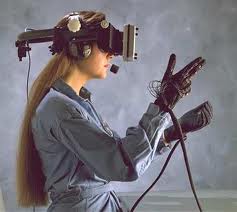As technology continues to advance, the tangible world is slowly seeping into a 'virtual reality' - an artificial means of transmitting reality (Strickland 2007). I remember as a kid loving to go outside and play soccer, but nowadays, it's probably more popular to play soccer as a video game. Everybody in the Western world uses a computer, and the days of pen and paper are becoming more and more extinct. Video games, computers, phones, television, radio and basically any technological platform used to communicate information is a virtual reality, and its popularity growth has been exponential in the last century, especially the last decade (Strickland 2007).
Cyberspace is a factor that exists within virtual reality - it refers to the realm of computer networking and metaphorically "gives the sense of a social setting that exists purely within a space or representation and communication" (Slater 2002).
William Sherman and Alan Craig's book 'Understanding Virtual Reality' explains the confusing relationship between the two much more clearly. Cyberspace, he explains, is "a location that exists only in the minds of the participants, often as a result of technology that enables geographically distant people to interactively communicate" (2003, p. 17). Cyberspace is therefore a social interaction that requires mental immersion between people, whereas virtual reality is a sensory immersion that is "not necessarily among multiple people, but rather between a person and a [computer-mediated] virtual world (which may not include other people)" (Craig, Sherman 2003, p. 23).
However, these elusive concepts are becoming more real in western culture and everyday life. Everyday life used to consist of the 'mundane' and the 'traditional', and cyberspace and virtual reality was an exciting new world that was apart from reality... But now, cyberspace has shaped and become our reality for communication, and western culture would not have advanced without it.
References
Craig, A & Sherman, W 2003, Understanding Virtual Reality, Morgan Kaufmann Publishers, San Fransisco
Slater, D 2002, Social Relationships and Identity Online and Offline, viewed 6 September 2012, <http://www.dourish.com/classes/readings/Slater-SocialRelationshipsIdentity.pdf>
Strickland, J 2007, How Virtual Reality Works, viewed 6 September 2012, <http://electronics.howstuffworks.com/gadgets/other-gadgets/virtual-reality.htm>

No comments:
Post a Comment